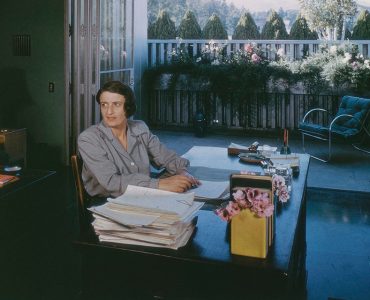In her youth, Ayn Rand experienced firsthand one of the most violent revolutions in history — the communist takeover of Russia that started in October 1917. Looking back at one indelible episode from her life in that tumultuous period, we can see how great art helped a young Ayn Rand to cope with those hellish events and preserve a vision of “her kind of world.”
Born Alisa Rosenbaum, Rand was raised in a secular Jewish family in St. Petersburg (renamed Petrograd in 1914). During the revolution, the Bolsheviks seized money deposited in banks, nationalized businesses, and confiscated property, including her father’s pharmacy. Targeted as enemies of the revolution, middle-class families like the Rosenbaums struggled to survive as supply lines of food and fuel were collapsing in the war-ravaged country.
The family fled the city in the fall of 1918 with whatever possessions they could carry. After spending their winter in Ukraine, they boarded a train to Crimea, a part of Russia not controlled by the communists. But their journey by rail was cut short: the tracks ahead had been destroyed. The Rosenbaums, along with several other passengers, were forced to proceed to their destination via horse-drawn carts.
In the middle of the night, as the carts rattled along a country road, a gunshot suddenly rang out. Armed men forced the procession of horse carts to stop. They ordered everyone to disembark, hand over their money, and stand with their backs turned while the robbers searched for valuables. In biographical interviews now housed in the Ayn Rand Archives, Rand recalled that “they warned that anyone who tried to hide money would be shot. I later discovered, incidentally, that while they were searching the first wagon, Father took his money and slipped it into the straw of that carriage . . . he was really taking a chance on his life.”1
With guns drawn upon her, the fourteen-year-old Rand recalled being frightened, but was unable to “really take it seriously. You know the sense in which, at that age . . . one can’t quite believe it is the end.” At that moment, a single thought gave her courage: the heroic life and death of Enjolras from Victor Hugo’s Les Misérables, a character Rand had “fallen in love with” in her youth. As she recounted decades later, “I thought: If I am shot now, at least I have had something. . . . The Enjolras scene out of Les Misérables. . . . if they are going to shoot, I want to die as well as he did. And I’ve always remembered it since — when you speak of the importance of fiction to young people. . . . if they are going to shoot, that’s what I want to be thinking of last — not of Russia nor the horrors.”2
The robbers did not find the money that Rand’s father had hidden, and the family proceeded to Crimea. They endured constant uncertainty for the next two years, as the town they lived in changed hands multiple times during the civil war. As Rand later recalled, “That is when we began to starve, literally. . . . There were enormous epidemics of [scurvy] . . . you could not tell from day to day whether you would have food or not.”3 Despite all this, Rand’s father held out hope that he could reclaim his business and property.4 The family returned to Petrograd in the fall of 1921, an experience that would serve as inspiration for her first novel, We the Living.
Ayn Rand’s harrowing journey from Petrograd to Crimea reminds us that great art has the power to uplift a person’s soul, even in the face of terrible evils. For Rand, Hugo’s romantic literature offered a vision of the world as it “might be and ought to be,” a respite from the hardship all around her. “I remember it as the most dramatic form of what Hugo meant to me or of what literature can mean to you. . . . What I like about myself in that scene and what I would still want to be my attitude is the conscious thinking: if it’s the last, I want it to be my kind of world.”5
Ayn Rand’s experience during the Russian Revolution is one of countless recollections she shared during biographical interviews recorded between 1960 and 1961. To hear Rand tell these stories in her own words, ARI Members are invited to join an exclusive Members-only Roundtable on Saturday, December 7, 2024, featuring excerpts from this fascinating and rare audio. The event will be the second in a series of episodic releases of Rand’s biographical interviews, spanning from Rand’s earliest days in Russia all the way to the publication of Atlas Shrugged. To participate in this experience, consider becoming an ARI Member today.
Marquee image: Photograph of Ayn Rand (center) with her sisters Nora (left) and Natasha (right), ca. 1914.
Do you have a comment or question?
Endnotes
- Biographical interviews (Ayn Rand Archives).
- Biographical interviews (Ayn Rand Archives).
- Biographical interviews (Ayn Rand Archives).
- This hope was likely prompted by the Soviet Union’s “New Economic Policy.” In a report dated October 21, 1921, Vladimir Lenin described the policy as “a strategical retreat” that would revert the Soviet economy “to capitalism to a considerable extent.” As Rand describes in We the Living, this involved allowing the existence of private stores. Vladimir Lenin, “The New Economic Policy,” The New Economic Policy and the Tasks of the Political Education Departments, https://www.marxists.org/archive/lenin/works/1921/oct/17.htm.
- Biographical interviews (Ayn Rand Archives).







